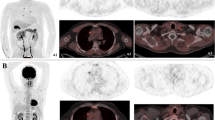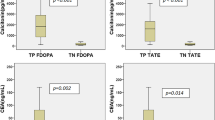Abstract
Purpose
18F-DOPA Positron Emission Tomography/Computed Tomography (18F-DOPA PET/CT) is a sensitive functional imaging method (65–75%) for detecting disease localization in medullary thyroid cancer (MTC). We aimed: (i) to assess the clinical usefulness of 18F-DOPA PET/CT in patients with MTC and elevated calcitonin (Ctn) and CEA levels and, (ii) to evaluate changes in disease management secondary to the findings encountered with this methodology.
Methods
Thirty-six patients with MTC and Ctn levels ≥150 pg/ml were prospectively included. Neck ultrasound, chest contrast-enhanced CT, liver magnetic resonance imaging/abdominal three-phase contrast-enhanced CT and bone scintigraphy were carried out up to 6 months before the 18F DOPA PET/CT.
Results
Seventy eight percent of patients were female and 27% had hereditary MTC. Median Ctn level was 1450 pg/ml [150–56620], median CEA level 413 ng/ml [2.9–7436]. Median Ctn DT was 37.5 months [5.7–240]; median CEA DT was 31.8 [4.9–180]. 18F-DOPA PET/CT was positive in 33 patients (91.6%); in 18 (56%) uptake was observed in lymph nodes in the neck or mediastinum, in seven cases (22%) distant metastases were diagnosed, and in eight additional patients (24%) both locoregional and distant sites of disease were found. Ctn and CEA levels were higher in patients with ≥3 foci of distant metastases. In 14 patients (38.8%), findings on 18F-DOPA PET/CT led to changes in management; surgery for locoregional lymph nodes was the most frequent procedure in 8 patients (22%).
Conclusion
18F-DOPA PET/CT was useful for the detection of recurrent disease in MTC, providing incremental value over conventional imaging procedures that led to modification in treatment strategies in nearly 40% of patients.



Similar content being viewed by others
Change history
06 June 2022
A Correction to this paper has been published: https://doi.org/10.1007/s12020-022-03093-w
References
S. Wells, Revised American Thyroid Association Guidelines for the management of medullary thyroid carcinoma. Thyroid 25(6), 567–590 (2015). https://doi.org/10.1089/thy.2014.0335
M.R. Pelizzo, Natural history, diagnosis, treatment and outcome of medullary thyroid cancer: 37 years experience on 157 patients. Eur. J. Surg. Oncol. 33(4), 493–497 (2007). https://doi.org/10.1016/j.ejso.2006.10.021
L. Louhibi, Demographic, clinical, and genetic characteristics of patients with medullary thyroid cancer in the past 16 years in Castilla-La Mancha. Endocrinol. Nutr. 61(8), 398–403 (2014). https://doi.org/10.1016/j.endonu.2014.02.006
K.S. Slavikova, What is currently the best radiopharmaceutical for the hybrid PET/CT detection of recurrent medullary thyroid carcinoma? Curr. Radiopharm. 6(2), 96–105 (2013). https://doi.org/10.2174/1874471011306020006.
S. Filetti, Thyroid Cancer: ESMO Clinical Practice Guidelines for Diagnosis, Treatment and Follow-up. Ann. Oncol. 30(12), 1856–1883 (2019). https://doi.org/10.1093/annonc/mdz400
A. Giraudet, Imaging medullary thyroid carcinoma with persistently elevated calcitonin levels. J. Clin. Endocrinol. Metab. 92(11), 4185–4190 (2007). https://doi.org/10.1210/jc.2007-1211
G. Treglia, Detection rate of recurrent medullary thyroid carcinoma using fluorine-18 fluorodeoxyglucose positron emission tomography: a meta-analysis. Endocrine 42, 535–545 (2012). https://doi.org/10.1007/s12020-012-9671-6
J. Yang, The combined use of calcitonin doubling time and 18F-FDG PET/CT improves prognostic values in medullary thyroid carcinoma: the clinical utility of 18F-FDG PET/CT. Endocr. Pr. 23(8), 942–948 (2017). https://doi.org/10.4158/EP171806.OR
Y. Ito, Calcitonin doubling time in medullary thyroid carcinoma after the detection of distant metastases keenly predicts patients’ carcinoma death. Endocr. J. 63(7), 663–667 (2016). https://doi.org/10.1507/endocrj.EJ16-0140
L. Giovanella, EAMN practice guideline for PET TC imaging in medullary thyroid carcinoma. Eur. J. Nucl. Med. Mol. 47(1), 61–77 (2020). https://doi.org/10.1007/s00259-019-04458-6.
W. Melega, L-6-e8F]Fluoro-DOPA Metabolism in monkeys and humans: biochemical parameters for the formulation of tracer kinetic models with positron emission tomography. J. Cereb. Blood Flow. Metab. 11, 890–897 (1991). https://doi.org/10.1038/jcbfm.1991.154
M. Bergström, In vivo demostration of enzyme actity in endocrime pancreatric tumors: decarboxylation of carbon 11 DOPA to carbon 11 dopamine. J. Nucl. Med. 37, 32–37 (1996)
S. Hoegerle, 18F-DOPA positron emission tomography for tumour detection in patients with medullary thyroid carcinoma and elevated calcitonin levels. Eur. J. Nucl. Med. 28(1), 64–71 (2001). https://doi.org/10.1007/s002590000404
R. Haddad, NCCN Guidelines version 2.2021. Thyroid carcinoma. https://www.nccn.org/professionals/physician_gls/pdf/thyroid.pdf. Accessed 10/15/2021
A. Archier, (18)F-DOPA PET/CT in the diagnosis and localization of persistent medullary thyroid carcinoma. Eur. J. Nucl. Med. Mol. Imaging 43(6), 1027–1033 (2016). https://doi.org/10.1007/s00259-015-3227-y
F. Caobelli, Predictive and prognostic value of 18F-DOPA PET/CT in patients affected by recurrent medullary carcinoma of the thyroid. Ann. Nucl. Med. 1(32), 7–15 (2018). https://doi.org/10.1007/s12149-017-1213-0
W. Noordzij, Adrenal tracer uptake by 18F-FDOPA PET/CT in patients with pheochromocytoma and controls. Eur. J. Nucl. Med. Mol. Imaging 46, 1560–1566 (2019). https://doi.org/10.1007/s00259-019-04332-5
L. Brammen, Medullary thyroid carcinoma: do ultrasonography and F-DOPA-PET-CT influence the initial surgical strategy? Ann Surg. Oncol. 3919–3927 (2018). https://doi.org/10.1245/s10434-018-6829-3
S. Rasul, 18 F DOPA PET /TC in diagnosis and stating of primary thyroid carcinoma prior to surgery. Eur. J. Nucl. Mol. Imaging 45(12), 2159–2149 (2018). https://doi.org/10.1007/s00259-018-4045-9
M. Terroir, F-18-Dopa PET/CT is more sensitive than whole body MRI for the localization of persistent/recurrent disease of medullary thyroid. Thyroid 29 (10), 1457–1464, https://doi.org/10.1089/thy.2018.0351
S. Lee, Comparison of 5 different PET radiopharmaceuticals for the detection of recurrent medullary thyroid carcinoma: a network meta-analysis. Clin. Nucl. Med. 45, 341–348 (2020). https://doi.org/10.1097/RLU.0000000000002940
G. Treglia, Comparison of 18-F DOPA, 18-F FDG and 68Ga-Somatostatin analogue PET/CT in patients with recurrent medullary thyroid carcinoma. Eur. J. Nucl. Med. Mol. Imaging 39, 569–580 (2012). https://doi.org/10.1007/s00259-011-2031-6. 569-580
F. Castinetti, PET imaging in medullary thyroid carcinoma:time for reappraisal? Thyroid 31(2), 151–155 (2021). https://doi.org/10.1089/thy.2020.0674
F. Calabria, 18 F- DOPA . In: Radiopharmaceuticals. A guide to PET/CT and PET/MRI, ed. F. Calabria, O. Schillaci (Springer Nature Switzerland AG) (2020, second edition), p. 37–57.
Acknowledgements
We thank Drs. Eduardo Faure and Soledad Berlingieri for the referral of patients.
Author information
Authors and Affiliations
Corresponding author
Ethics declarations
Conflict of interest
The authors declare no competing interests.
Ethical approval
All procedures performed in this study were in accordance with the ethical standards of the institutional research committee and with the principles of the 1964 Declaration of Helsinki and its later amendments.
Informed consent
Written informed consent was obtained from every participant patient.
Additional information
Publisher’s note Springer Nature remains neutral with regard to jurisdictional claims in published maps and institutional affiliations.
Rights and permissions
About this article
Cite this article
Califano, I., Pitoia, F., Chirico, R. et al. Prospective study on the clinical relevance of 18F-DOPA positron emission tomography/computed tomography in patients with medullary thyroid carcinoma. Endocrine 77, 143–150 (2022). https://doi.org/10.1007/s12020-022-03062-3
Received:
Accepted:
Published:
Issue Date:
DOI: https://doi.org/10.1007/s12020-022-03062-3




